2003 CADILLAC SEVILLE jump start
[x] Cancel search: jump startPage 261 of 408
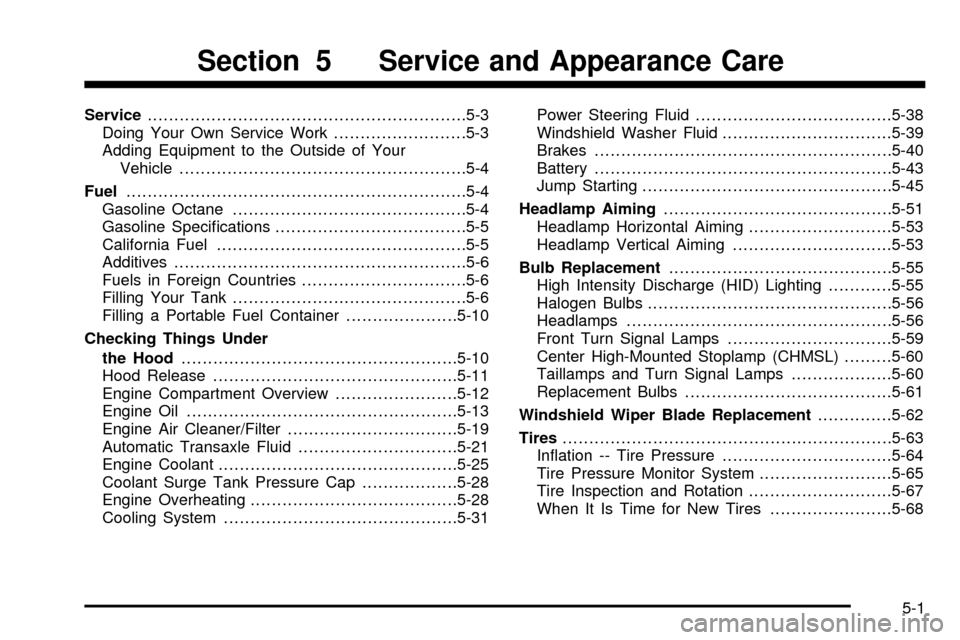
Service............................................................5-3
Doing Your Own Service Work.........................5-3
Adding Equipment to the Outside of Your
Vehicle......................................................5-4
Fuel................................................................5-4
Gasoline Octane............................................5-4
Gasoline Speci®cations....................................5-5
California Fuel...............................................5-5
Additives.......................................................5-6
Fuels in Foreign Countries...............................5-6
Filling Your Tank............................................5-6
Filling a Portable Fuel Container.....................5-10
Checking Things Under
the Hood....................................................5-10
Hood Release..............................................5-11
Engine Compartment Overview.......................5-12
Engine Oil...................................................5-13
Engine Air Cleaner/Filter................................5-19
Automatic Transaxle Fluid..............................5-21
Engine Coolant.............................................5-25
Coolant Surge Tank Pressure Cap..................5-28
Engine Overheating.......................................5-28
Cooling System............................................5-31Power Steering Fluid.....................................5-38
Windshield Washer Fluid................................5-39
Brakes........................................................5-40
Battery........................................................5-43
Jump Starting...............................................5-45
Headlamp Aiming...........................................5-51
Headlamp Horizontal Aiming...........................5-53
Headlamp Vertical Aiming..............................5-53
Bulb Replacement..........................................5-55
High Intensity Discharge (HID) Lighting............5-55
Halogen Bulbs..............................................5-56
Headlamps..................................................5-56
Front Turn Signal Lamps...............................5-59
Center High-Mounted Stoplamp (CHMSL).........5-60
Taillamps and Turn Signal Lamps...................5-60
Replacement Bulbs.......................................5-61
Windshield Wiper Blade Replacement..............5-62
Tires..............................................................5-63
In¯ation -- Tire Pressure................................5-64
Tire Pressure Monitor System.........................5-65
Tire Inspection and Rotation...........................5-67
When It Is Time for New Tires.......................5-68
Section 5 Service and Appearance Care
5-1
Page 303 of 408

Replacing Brake System Parts
The braking system on a vehicle is complex. Its many
parts have to be of top quality and work well together if
the vehicle is to have really good braking. Your
vehicle was designed and tested with top-quality GM
brake parts. When you replace parts of your braking
system Ð for example, when your brake linings
wear down and you need new ones put in Ð be sure
you get new approved replacement parts. If you do not,
your brakes may no longer work properly. For
example, if someone puts in brake linings that are
wrong for your vehicle, the balance between your front
and rear brakes can change Ð for the worse. The
braking performance you have come to expect
can change in many other ways if someone puts in the
wrong replacement brake parts.
Battery
Your new vehicle comes with a maintenance free
ACDelcožbattery. When it's time for a new battery, get
one that has the replacement number shown on the
original battery's label. We recommend an
ACDelco
žbattery.
Warning:Battery posts, terminals and related
accessories contain lead and lead compounds,
chemicals known to the State of California to cause
cancer and reproductive harm. Wash hands after
handling.
The battery is located under the rear seat cushion. To
access the battery, see ªRemoving the Rear Seat
Cushionº. You don't need to access the battery to jump
start your vehicle. See
Jump Starting on page 5-45.
{CAUTION:
A battery that isn't properly vented can let
sulfuric acid fumes into the area under the rear
seat cushion. These fumes can damage your
rear seat safety belt systems. You may not be
able to see this damage, and the safety belts
might not provide the protection needed in a
crash. If a replacement battery is ever needed,
it must be vented in the same manner as the
original battery. Always make sure that the
vent hose is properly reattached before
reinstalling the seat cushion.
5-43
Page 304 of 408
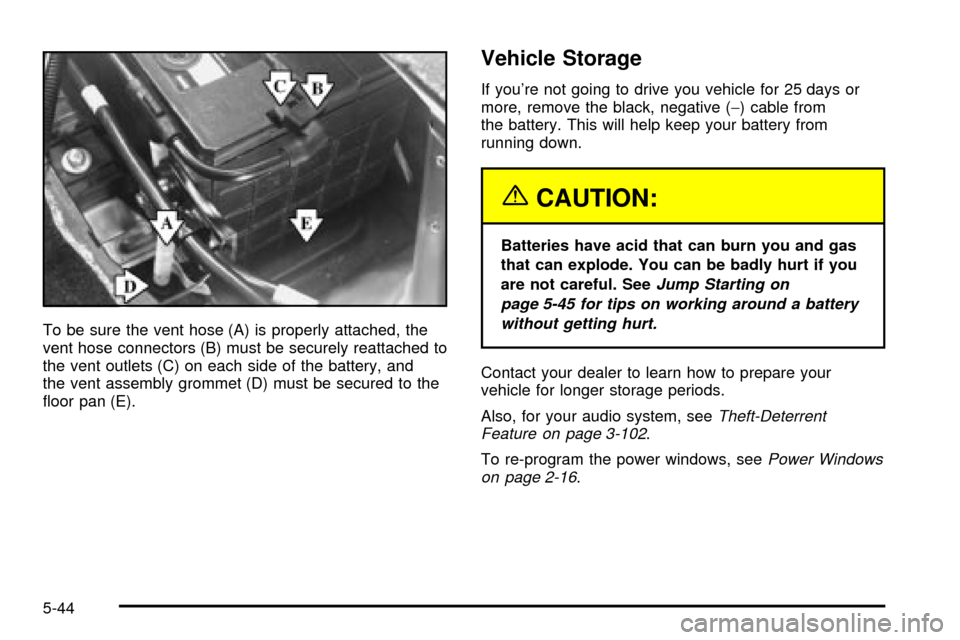
To be sure the vent hose (A) is properly attached, the
vent hose connectors (B) must be securely reattached to
the vent outlets (C) on each side of the battery, and
the vent assembly grommet (D) must be secured to the
¯oor pan (E).
Vehicle Storage
If you're not going to drive you vehicle for 25 days or
more, remove the black, negative (-) cable from
the battery. This will help keep your battery from
running down.
{CAUTION:
Batteries have acid that can burn you and gas
that can explode. You can be badly hurt if you
are not careful. See
Jump Starting on
page 5-45 for tips on working around a battery
without getting hurt.
Contact your dealer to learn how to prepare your
vehicle for longer storage periods.
Also, for your audio system, see
Theft-Deterrent
Feature on page 3-102.
To re-program the power windows, see
Power Windows
on page 2-16.
5-44
Page 305 of 408
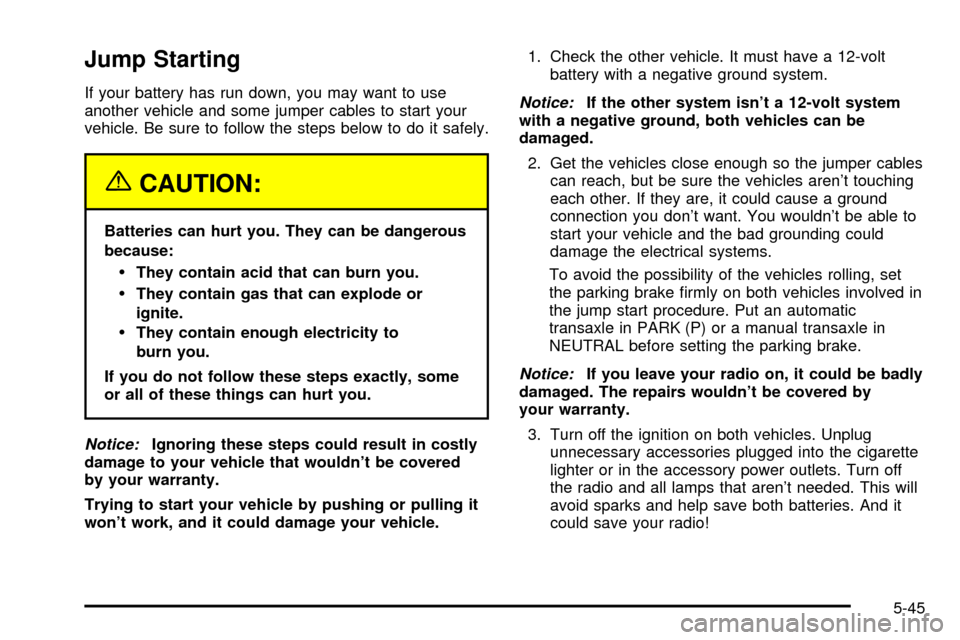
Jump Starting
If your battery has run down, you may want to use
another vehicle and some jumper cables to start your
vehicle. Be sure to follow the steps below to do it safely.
{CAUTION:
Batteries can hurt you. They can be dangerous
because:
·They contain acid that can burn you.
·They contain gas that can explode or
ignite.
·They contain enough electricity to
burn you.
If you do not follow these steps exactly, some
or all of these things can hurt you.
Notice:Ignoring these steps could result in costly
damage to your vehicle that wouldn't be covered
by your warranty.
Trying to start your vehicle by pushing or pulling it
won't work, and it could damage your vehicle.1. Check the other vehicle. It must have a 12-volt
battery with a negative ground system.
Notice:If the other system isn't a 12-volt system
with a negative ground, both vehicles can be
damaged.
2. Get the vehicles close enough so the jumper cables
can reach, but be sure the vehicles aren't touching
each other. If they are, it could cause a ground
connection you don't want. You wouldn't be able to
start your vehicle and the bad grounding could
damage the electrical systems.
To avoid the possibility of the vehicles rolling, set
the parking brake ®rmly on both vehicles involved in
the jump start procedure. Put an automatic
transaxle in PARK (P) or a manual transaxle in
NEUTRAL before setting the parking brake.
Notice:If you leave your radio on, it could be badly
damaged. The repairs wouldn't be covered by
your warranty.
3. Turn off the ignition on both vehicles. Unplug
unnecessary accessories plugged into the cigarette
lighter or in the accessory power outlets. Turn off
the radio and all lamps that aren't needed. This will
avoid sparks and help save both batteries. And it
could save your radio!
5-45
Page 306 of 408
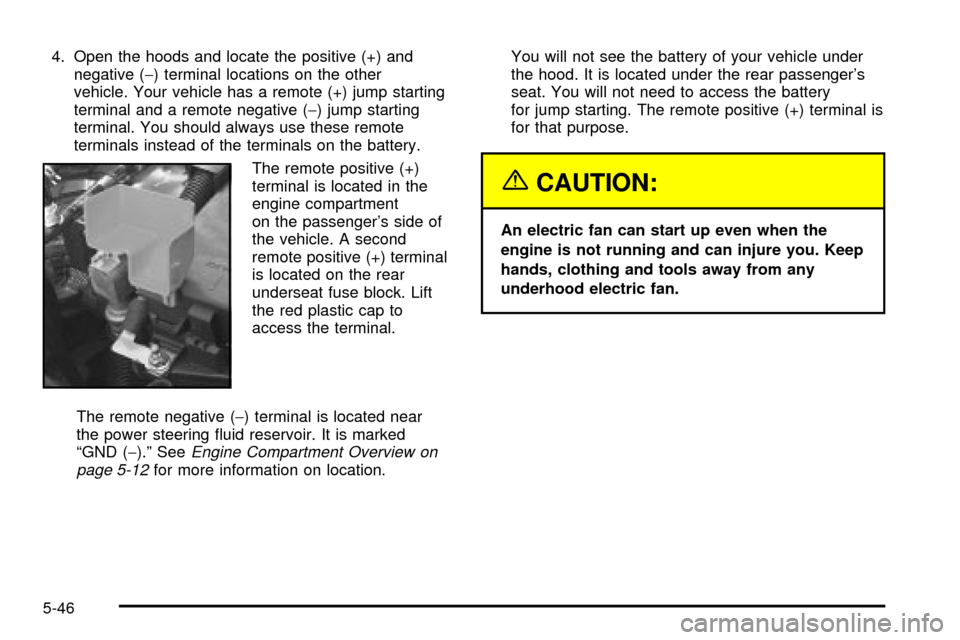
4. Open the hoods and locate the positive (+) and
negative (-) terminal locations on the other
vehicle. Your vehicle has a remote (+) jump starting
terminal and a remote negative (-) jump starting
terminal. You should always use these remote
terminals instead of the terminals on the battery.
The remote positive (+)
terminal is located in the
engine compartment
on the passenger's side of
the vehicle. A second
remote positive (+) terminal
is located on the rear
underseat fuse block. Lift
the red plastic cap to
access the terminal.
The remote negative (-) terminal is located near
the power steering ¯uid reservoir. It is marked
ªGND (-).º See
Engine Compartment Overview on
page 5-12for more information on location.You will not see the battery of your vehicle under
the hood. It is located under the rear passenger's
seat. You will not need to access the battery
for jump starting. The remote positive (+) terminal is
for that purpose.
{CAUTION:
An electric fan can start up even when the
engine is not running and can injure you. Keep
hands, clothing and tools away from any
underhood electric fan.
5-46
Page 309 of 408
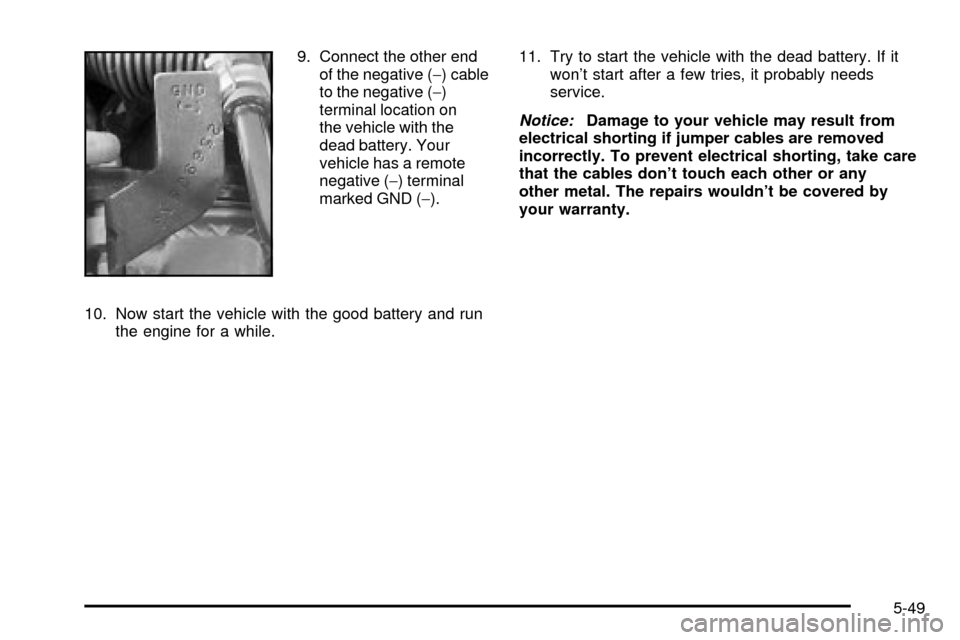
9. Connect the other end
of the negative (-) cable
to the negative (-)
terminal location on
the vehicle with the
dead battery. Your
vehicle has a remote
negative (-) terminal
marked GND (-).
10. Now start the vehicle with the good battery and run
the engine for a while.11. Try to start the vehicle with the dead battery. If it
won't start after a few tries, it probably needs
service.
Notice:Damage to your vehicle may result from
electrical shorting if jumper cables are removed
incorrectly. To prevent electrical shorting, take care
that the cables don't touch each other or any
other metal. The repairs wouldn't be covered by
your warranty.
5-49
Page 386 of 408
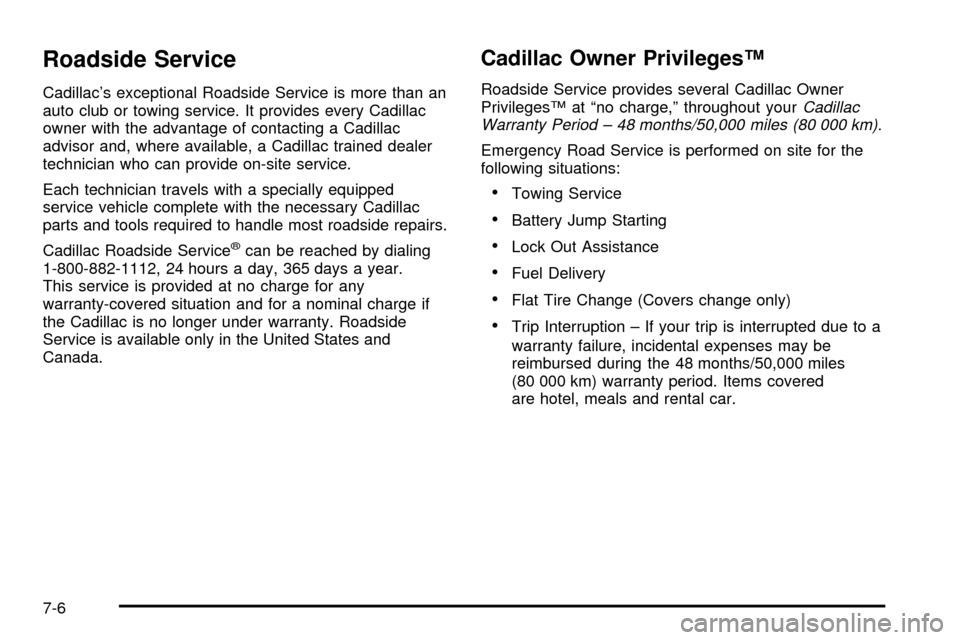
Roadside Service
Cadillac's exceptional Roadside Service is more than an
auto club or towing service. It provides every Cadillac
owner with the advantage of contacting a Cadillac
advisor and, where available, a Cadillac trained dealer
technician who can provide on-site service.
Each technician travels with a specially equipped
service vehicle complete with the necessary Cadillac
parts and tools required to handle most roadside repairs.
Cadillac Roadside Service
žcan be reached by dialing
1-800-882-1112, 24 hours a day, 365 days a year.
This service is provided at no charge for any
warranty-covered situation and for a nominal charge if
the Cadillac is no longer under warranty. Roadside
Service is available only in the United States and
Canada.
Cadillac Owner PrivilegesŸ
Roadside Service provides several Cadillac Owner
PrivilegesŸ at ªno charge,º throughout yourCadillac
Warranty Period ± 48 months/50,000 miles (80 000 km).
Emergency Road Service is performed on site for the
following situations:
·Towing Service
·Battery Jump Starting
·Lock Out Assistance
·Fuel Delivery
·Flat Tire Change (Covers change only)
·Trip Interruption ± If your trip is interrupted due to a
warranty failure, incidental expenses may be
reimbursed during the 48 months/50,000 miles
(80 000 km) warranty period. Items covered
are hotel, meals and rental car.
7-6
Page 400 of 408

Instrument Panel.............................................3-38
Cluster.......................................................3-38
Overview..................................................... 3-4
Interior Lamps Control.....................................3-21
Interior Lamps................................................3-21
J
Jump Starting.................................................5-45
K
Key in Recall Memory.....................................3-65
Key Lock Cylinders Service..............................6-10
Keyless Entry System....................................... 2-5
Keys............................................................... 2-3
L
Lamps On Reminder.......................................3-17
Lamps...........................................................3-16
Exterior......................................................3-16
Interior.......................................................3-21
Lap-Shoulder Belt...................................1-12, 1-20
LATCH System...............................................1-36
Child Restraints...........................................1-36LATCH System (cont.)
Securing a Child Restraint Designed for the
LATCH System........................................1-38
Leaving Your Vehicle With the Engine Running . . . 2-33
Leaving Your Vehicle.......................................2-11
Lighted Visor Vanity Mirrors..............................2-18
Light.............................................................3-42
Air Bag Readiness.......................................3-42
Anti-Lock Brake System Warning...................3-44
Brake System Warning and Parking Brake
Indicator.................................................3-43
Charging System.........................................3-43
Cruise Control.............................................3-51
Engine Coolant Temperature Warning.............3-46
Fog Lamp..................................................3-51
Lights On Reminder.....................................3-51
Malfunction Indicator....................................3-47
Oil Pressure...............................................3-50
Safety Belt Reminder...................................3-41
Security.....................................................3-51
TCS Warning Light......................................3-45
Traction Control System (TCS) Warning..........3-45
Lights Flash at Lock........................................3-68
Lights Flash at Unlock.....................................3-68
Loading Your Vehicle.......................................4-33
Lockout Protection..........................................2-11
Locks............................................................2-10
Central Door Unlocking System.....................2-10
Door........................................................... 2-9
8